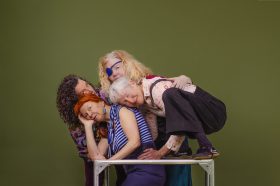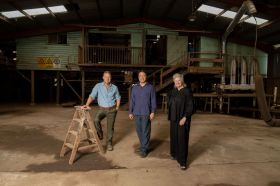Image: http://talltreessupportedliving.wordpress.com
There is no doubt that participation in the plethora of life’s activities is a key part of healthy and active ageing. For many Victorians getting out into the community and experiencing art in its many different forms provides personal enjoyment, enables a sense of connectedness and enhances the experience of community life. Arts practice provides another experience for people to age well in their communities.
Arts practice and good health go together – ‘arts as therapy’ is a therapeutic model that seeks improvements in health outcomes for people, similar to the way physical rehabilitation works. More broadly, participation in the arts can maintain a person’s health and wellbeing, or supplement the supports given to those people living with chronic health conditions, such as dementia or Parkinson’s disease. Evidence shows that arts programs in health settings reduce the time spent recuperating in hospital, reduce reliance on medications and foster self-esteem and a sense of achievement.
The parliamentary inquiry into ‘Opportunities for Participation of Victorian Seniors’ identified intergenerational activities as one key area for us to focus on as we build a more age-friendly community. What we also know from the parliamentary inquiry is that intergenerational activity can assist with challenging and breaking down negative stereotypes about the capabilities of seniors. Furthermore they identified that ‘perceptions of older people have a significant impact on their capacity to participate in society’.
Intergenerational activity with a focus on the arts is a powerful tool for social change in our communities.
The arts and the arts community provide an enormous amount of potential for all of us to expand the range of intergenerational programs that provide increased opportunities for seniors’ participation. Part of my role is to inspire people of all ages to think about how they can encourage and promote the ongoing active involvement of seniors in our community on a day-to-day basis. While there are excellent role models in various arts activities, it is important for each of us to challenge our thinking – how can we play a greater role in promoting the participation of seniors in community life – and there are just so many opportunities that the arts provide for this to occur.
In the period of time since I have been the Commissioner I have had the opportunity to learn about many projects, programs and organisations in Victoria that encourage older people to remain connected in their communities and continue to actively participate in life. I would like to take this opportunity to showcase a few examples in order to encourage those in the arts community to identify ways in which each of us can promote seniors participation.
Social isolation has an enormous negative impact on the health outcomes of older people and there is strong evidence active social participation is a major contributor to healthy living for seniors. Art practice has been shown to assist those at risk of social isolation. The Lochiel Lives and Waratah Wisdoms project run by Orbost Regional Health with funding from the Department of Health employed an artist-in-residence to teach seniors in residential aged care, at risk of social isolation and disconnection, how to paint and draw using different mediums. It won a national Aged & Community Care Victoria Award for excellence and was recognised for the ‘portrayal of older people in a positive light, clearly depicting social connectedness of the elderly residents’ living in Orbost Regional Health residential facilities.
By way of example, organisations such as Life Activities Club Victoria and U3A contribute enormously to Victorian communities by enabling seniors to enjoy full, healthy, satisfying and connected lives. Both organisations offer a wide and varied range of social, education and recreational opportunities including dancing, singing, photography, art, philosophy, and writing classes.
Members of these organisations can gain satisfaction, socialisation with other like-minded people and a sense of enjoyment and achievement from attending classes. If you have a moment, take a look at the different ways that the arts and arts activities are part of the U3A and Life Activity Clubs programs. Importantly, arts programs are inclusive and cross boundaries, involving people from different cultures or who speak English as a second language; people who may have difficulty expressing themselves due to illness or disability, may find they can communicate through the medium of art. Indeed the arts can play a role in encouraging people to explore their own creativity and provide people with a sense of personal fulfilment.
Rafael de la Paz, a Cuban poet and painter, is a U3A art tutor in Footscray. Rafael does not consider himself a ‘teacher’, rather he sees himself as someone who enables those who attend his classes to discover their own creative ideas and express themselves through their art. Rafael spoke of the personal fulfilment he receives from volunteering his time to assist seniors in their artistic endeavours – ‘you get a lot back, people in my classes are happy, they share their experiences and they talk to me and to one another.’
Both Life Activities Clubs and U3As rely on volunteer tutors, like Rafael, and activity organisers to pass on their skill and talent to the older people who attend their programs. Part of my role as Commissioner is to inspire others to think about how they may be able to make a further contribution to our community by supporting the active participation by seniors. The arts and arts community already make a most significant contribution to the active participation of seniors – but as our population ages there will be many more opportunities to support seniors participation. Volunteering provides great opportunities to strengthen our sense of personal fulfilment. As a volunteer you may be able to make a real difference to the quality of life in an older person’s life – there is so much opportunity to link social participation activities with the arts.
I encourage the arts community to reflect on the significant role that the arts can play in providing social participation opportunities for seniors as they age. I also encourage individuals to consider volunteering your time and get involved in engaging older Victorians in the arts. The benefits for the broader community are many – intergenerational activity breaks down barriers and stereotypes; it maintains, and over time, revitalises community facilities and public infrastructure.
There are an enormous number of state-wide and local community organisations that actively support seniors and would welcome a greater involvement by volunteers. This could be a local aged care home, a seniors day centre, local government groups, local church or service clubs and the list goes on. They are all just a phone call or email away.
Volunteering Victoria is the peak body for volunteering in Victoria with an aim to build a vibrant, prosperous and strong volunteering community that are inclusive, respected and sustainable. You can contact them: (03) 8327 8500 or website – http://volunteeringvictoria.org.au/
If you want to make contact with either U3As or Life Activities Clubs Victoria, you can contact them at: Life Activities Club Victoria – (03) 9662 2930 or website – http://www.life.org.au/ and U3A – (03) 9670 3659 or website – http://www.u3avictoria.com.au/





